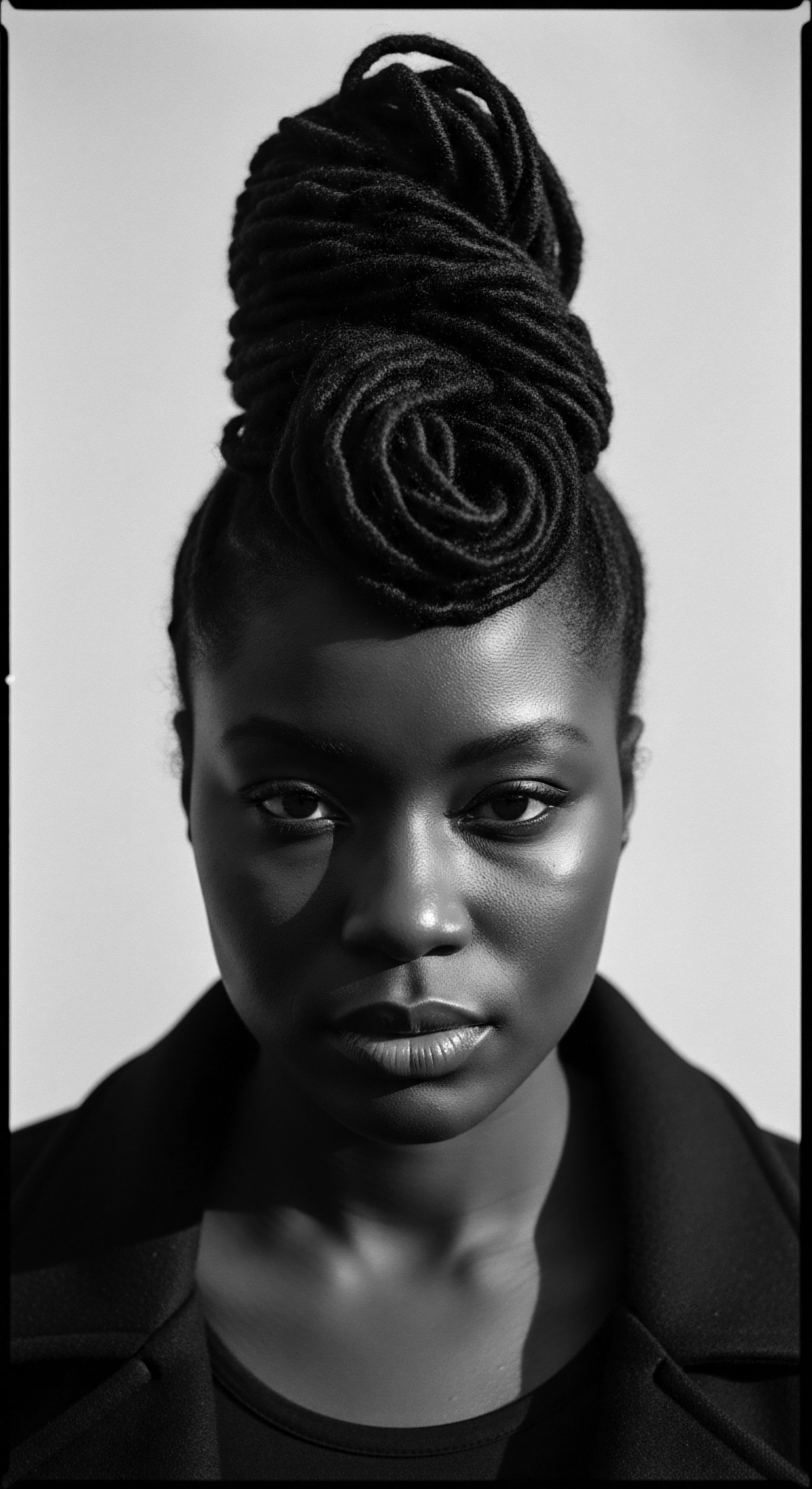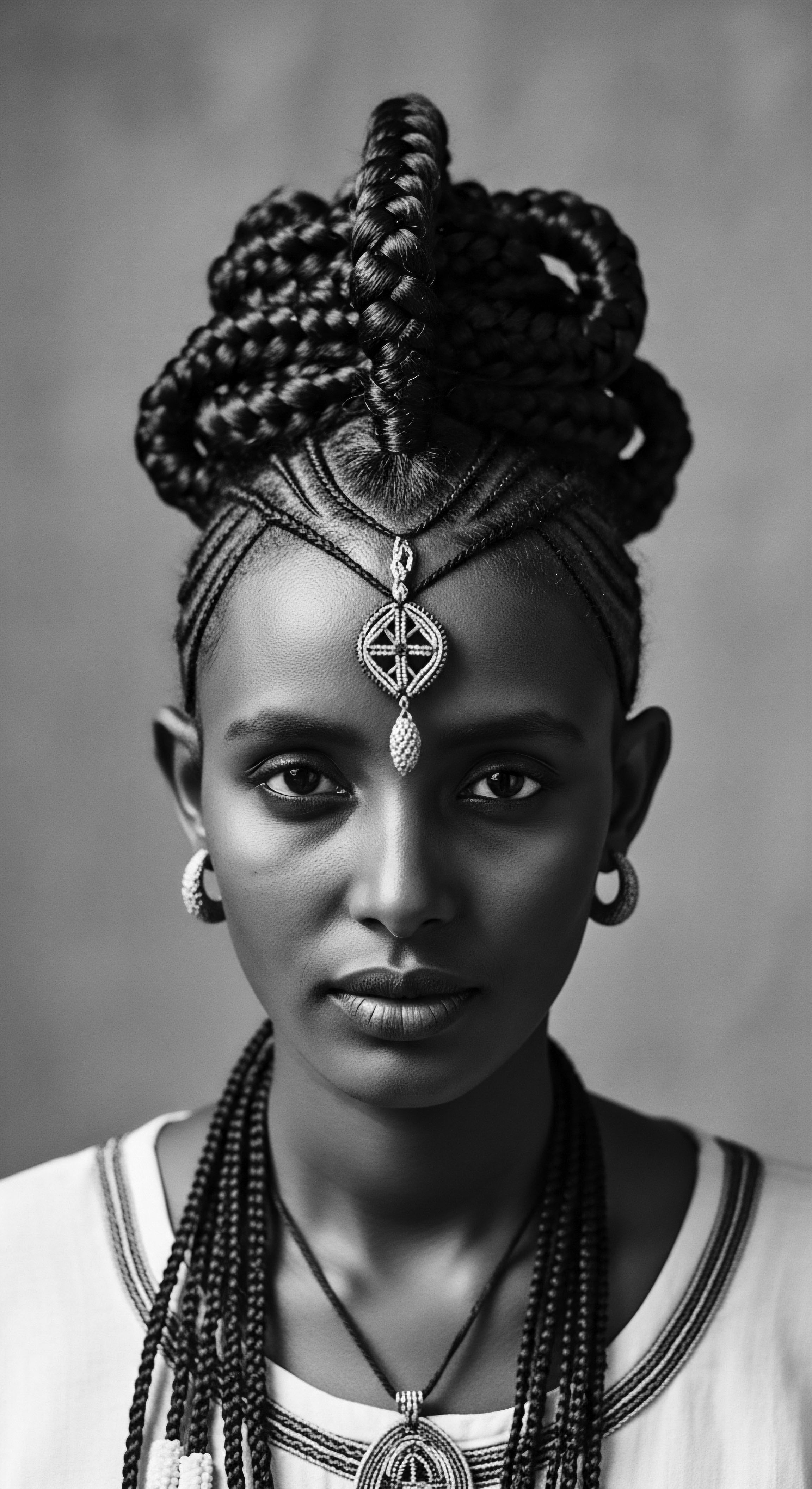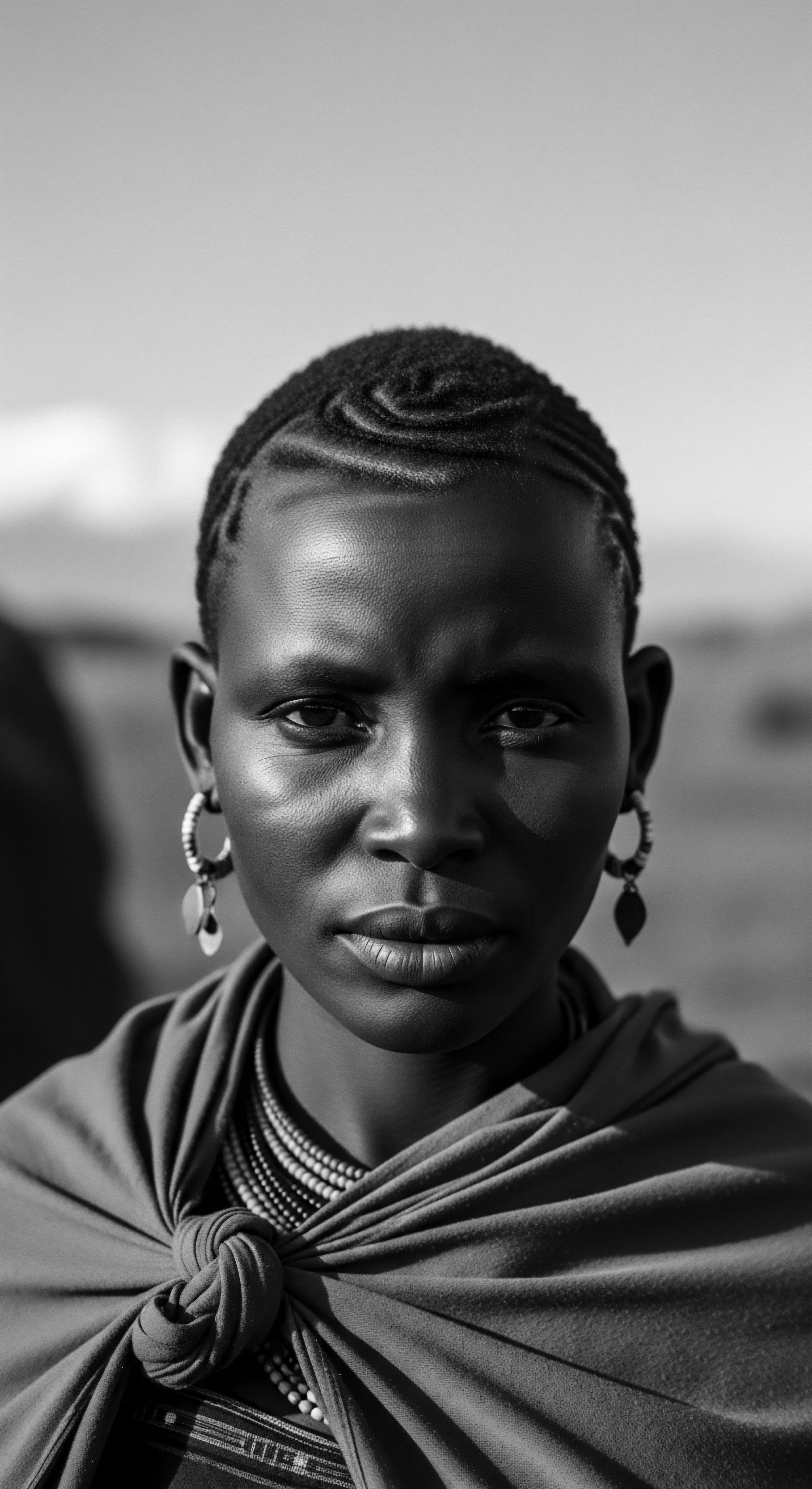
Fundamentals
The concept of Indigenous Beauty, within the expansive living library of Roothea, represents far more than a mere aesthetic preference; it stands as a fundamental recognition of the inherent, ancestral grace and vitality that resides within textured hair. This designation serves as an explanation, a clarification, for the deep-seated connection between hair, identity, and the enduring practices passed down through generations. It is a statement of intrinsic worth, acknowledging the distinct biological architecture of curls, coils, and waves, alongside the profound cultural narratives woven into their very being.
For those beginning their exploration into the rich heritage of textured hair, understanding Indigenous Beauty starts with recognizing hair not as something to be tamed or altered, but as a vibrant extension of self, a conduit of lineage. This perspective counters centuries of imposed standards that often dismissed the natural inclinations of Black and mixed-race hair. The meaning of Indigenous Beauty is rooted in the earth, in the wisdom of ancient civilizations that saw hair as a sacred adornment, a spiritual antenna, and a marker of status, tribe, and life stage. It is a delineation of beauty that originates from within a community’s own history and practices, rather than from external validation.
Indigenous Beauty, at its core, is the recognition of textured hair’s intrinsic splendor, rooted in ancestral wisdom and the biological realities of its unique structure.
The initial comprehension of this term invites us to consider the simple yet powerful act of looking at a strand of hair—a coil, a wave—and perceiving its complete, unadulterated loveliness. This involves appreciating its natural curl pattern, its strength, its capacity for intricate styles, and its ability to tell stories without uttering a single word. This initial interpretation also prompts a gentle re-evaluation of what constitutes ‘beautiful’ in the realm of hair, moving away from universalized, often Eurocentric, ideals towards a reverence for natural, inherited forms.

Early Understandings of Hair’s Sacredness
Across various ancestral traditions, hair held a position of reverence, a physical manifestation of spiritual and communal ties. Ancient African civilizations, for instance, regarded hair as a direct link to the divine, a symbol of fertility, prosperity, and connection to one’s ancestors. The way hair was styled, adorned, and cared for reflected complex social structures and spiritual beliefs. This foundational understanding shapes our contemporary view of Indigenous Beauty, reminding us that its significance extends beyond the superficial.
This elemental connection meant that hair care rituals were not merely cosmetic acts; they were profound practices of self-care, community bonding, and spiritual alignment. From the preparation of natural oils and butters to the meticulous braiding and twisting sessions, these traditions affirmed the inherent beauty of textured hair and reinforced cultural identity. The explication of Indigenous Beauty therefore begins with these timeless customs, which laid the groundwork for a deeply holistic approach to hair wellness.
- Adornment ❉ Hair was often adorned with shells, beads, and precious metals, signifying status or spiritual connection.
- Ritual ❉ Hair care rituals, such as cleansing with natural clays or oiling with plant extracts, were communal and generational.
- Symbolism ❉ Specific styles conveyed messages about marital status, age, or tribal affiliation.

Intermediate
Advancing beyond the foundational understanding, the intermediate interpretation of Indigenous Beauty deepens into its significance as a counter-narrative to historical suppression and a powerful reclamation of self. This elucidation delves into the period when the inherent splendor of textured hair was systematically devalued, and how communities persevered, maintaining a quiet, yet resolute, dedication to their ancestral hair practices. It is a delineation that acknowledges the historical trauma associated with hair discrimination while simultaneously celebrating the enduring spirit of resilience.
The meaning here expands to encompass the intentional act of honoring one’s natural hair texture, understanding that this act is a profound statement of identity and resistance. It recognizes the scientific realities of textured hair – its unique follicular structure, its propensity for dryness, its need for specific moisture-retaining care – and links these biological truths directly to the ancestral practices that intuitively addressed these needs. This connection between elemental biology and ancient wisdom forms a crucial aspect of the intermediate comprehension of Indigenous Beauty.
The enduring power of Indigenous Beauty lies in its capacity to heal historical wounds, affirming textured hair as a symbol of cultural pride and an unbroken link to ancestral wisdom.

The Tender Thread of Traditional Care
Traditional hair care practices, passed through oral traditions and lived experience, represent a living library of knowledge that directly informs the understanding of Indigenous Beauty. These practices were not born of scientific laboratories, but from generations of observation, experimentation, and a deep, intuitive understanding of the hair’s needs within specific environments. Consider the use of plant-based ingredients ❉
| Ancestral Ingredient/Practice Shea Butter (Karité) |
| Traditional Application & Significance Used extensively across West Africa for moisturizing skin and hair, protecting against sun and dryness; revered for its nourishing properties. |
| Contemporary Scientific Affirmation Rich in fatty acids (oleic, stearic) and vitamins A, E, F; known for emollient properties, sealing in moisture, and reducing breakage in textured hair. |
| Ancestral Ingredient/Practice Aloe Vera |
| Traditional Application & Significance Applied for soothing scalp irritations, promoting growth, and conditioning hair in various African and Indigenous cultures. |
| Contemporary Scientific Affirmation Contains proteolytic enzymes that repair dead skin cells on the scalp, acts as a great conditioner, and promotes hair growth; provides moisture and shine. |
| Ancestral Ingredient/Practice Hot Oil Treatments |
| Traditional Application & Significance Warm oils (like coconut or olive) massaged into scalp and hair to stimulate growth and add luster; often a communal ritual. |
| Contemporary Scientific Affirmation Heat helps oils penetrate the hair shaft more effectively, providing deep conditioning, reducing hygral fatigue, and improving elasticity. |
| Ancestral Ingredient/Practice These examples underscore how ancestral wisdom, often intuitive, finds corroboration in modern understanding, affirming the foundational role of heritage in hair care. |
The deliberate choice to honor these practices today, to seek out ingredients and methods that align with ancestral wisdom, constitutes a powerful act of self-determination. This is where the passionate hair wellness advocate voice truly resonates, guiding individuals to reconnect with their hair’s lineage. It is an ethical framing of hair practices, prompting consideration of how products and routines align with the historical context of textured hair care.

Reclaiming Identity Through Hair
The historical context of Indigenous Beauty is inseparable from the struggles for identity and self-acceptance faced by Black and mixed-race communities. For centuries, textured hair was subjected to scrutiny, deemed ‘unprofessional’ or ‘unruly’ in dominant societal narratives. The intermediate understanding recognizes that reclaiming Indigenous Beauty is a deliberate act of dismantling these harmful constructs. It involves a journey of self-discovery, where individuals learn to appreciate the unique characteristics of their hair and see it as a source of strength, not a deficiency.
This phase of comprehension invites a deeper look into the cultural movements that championed natural hair, such as the Black Power movement of the 1960s and 70s, and the contemporary natural hair movement. These periods saw a resurgence of traditional styles and a collective affirmation of textured hair as a political statement and a celebration of heritage. The concept of Indigenous Beauty, therefore, serves as a powerful lens through which to examine these historical shifts and their ongoing impact on self-perception and communal pride.
- Afro ❉ A powerful symbol of Black pride and defiance against assimilation during the civil rights era.
- Braids ❉ Styles like cornrows and box braids, with roots in ancient African traditions, became expressions of cultural continuity.
- Twists ❉ Two-strand twists and other natural forms offered protective styling while honoring natural texture.

Academic
The academic elucidation of Indigenous Beauty posits it as a complex, socio-cultural construct and a biological reality, inextricably linked to the historical experiences and ancestral practices of communities with textured hair, particularly those within the African diaspora. This scholarly definition extends beyond mere aesthetic appreciation, functioning as a critical framework for analyzing the interplay of biological predispositions, cultural memory, systemic oppression, and contemporary reclamation movements. It is a precise specification that recognizes the inherent, unadulterated splendor of textured hair as a cornerstone of identity, self-worth, and cultural continuity, challenging hegemonic beauty standards and advocating for a decolonized understanding of beauty. The term’s meaning is deeply rooted in the enduring legacy of ancestral knowledge, validated and often illuminated by contemporary scientific inquiry, providing a comprehensive exploration of its significance.
From an academic vantage, Indigenous Beauty represents the convergence of ethnobotanical wisdom, dermatological science, and cultural anthropology. The distinctive helical structure of textured hair, its varying curl patterns from loose waves to tight coils, and its inherent susceptibility to dryness due to reduced sebum distribution along the hair shaft, are biological facts that ancient practices intuitively addressed. The traditional use of rich emollients, protective styling, and gentle cleansing agents, often derived from indigenous flora, exemplifies a sophisticated, ancestral understanding of hair physiology long before modern scientific methods could validate their efficacy. This interconnectedness underscores the profound intelligence embedded within heritage.

The Psychosocial Ramifications of Hair Discrimination and the Reassertion of Indigenous Beauty
The academic discourse surrounding Indigenous Beauty cannot bypass the pervasive historical and ongoing impact of hair discrimination, particularly within professional and educational spheres. This discrimination, often rooted in anti-Black racism, has systematically marginalized natural textured hairstyles, imposing Eurocentric beauty norms as the standard of professionalism and acceptability. Such systemic biases have significant psychosocial consequences, impacting self-esteem, mental well-being, and economic opportunities for individuals with textured hair.
A rigorous examination of this phenomenon reveals a disturbing pattern. For instance, a seminal study by Roberts and Roberts (2019) published in the Journal of Black Psychology titled “Perceptions of professional appearance among African American women with natural hairstyles” found that African American women often experience pressure to conform to mainstream beauty standards in professional settings. Their research highlighted that many Black women reported modifying their natural hairstyles to avoid negative perceptions or discrimination in the workplace. This particular study, drawing from qualitative data, elucidated the emotional labor involved in navigating these biased environments, where the very expression of Indigenous Beauty could be a barrier to advancement.
The authors concluded that these pressures contribute to significant psychological distress and feelings of inauthenticity among Black women in professional spaces (Roberts & Roberts, 2019). This compelling evidence underscores the critical need for a re-evaluation of societal beauty norms and a widespread acceptance of Indigenous Beauty.
The pressure to conform to Eurocentric beauty standards in professional settings often compels Black women to alter their natural hairstyles, leading to significant psychological distress and a sense of inauthenticity.
The implications of such findings are far-reaching, extending beyond individual experiences to broader societal structures. The ongoing legislative efforts, such as the CROWN Act in the United States, which prohibits discrimination based on hair texture and protective hairstyles, represent a direct societal response to this historical and academic understanding. These legislative movements are not merely legal reforms; they are acknowledgments of the deep cultural and psychological significance of hair and a societal affirmation of Indigenous Beauty as a legitimate and respected form of self-expression. They reflect a growing collective understanding that the freedom to wear one’s hair in its natural state is a fundamental human right, deeply intertwined with dignity and identity.

The Unbound Helix ❉ Biocultural Evolution and Future Trajectories
The academic lens further allows for an exploration of Indigenous Beauty through the concept of the “Unbound Helix”—a metaphor for the intrinsic freedom and evolutionary journey of textured hair. This perspective considers how the biological helix of the hair strand itself, with its unique structural properties, has historically been both a site of cultural innovation and a target of oppressive ideologies. The “unbinding” refers to the contemporary movement towards liberation from these historical constraints, allowing the natural helix to exist and flourish without external imposition.
This involves a deeper dive into the concept of Epigenetics and its potential, albeit nascent, connection to hair. While direct epigenetic modification of hair texture itself is not widely established, the broader field of epigenetics explores how environmental factors and lived experiences can influence gene expression. From a metaphorical standpoint, the trauma of discrimination or the celebration of ancestral practices could be seen as shaping the collective consciousness around hair, influencing how future generations perceive and care for their textured strands. This conceptual connection invites further interdisciplinary research into the long-term impacts of cultural narratives on biological and psychological well-being.
The academic definition of Indigenous Beauty also calls for an examination of the global implications of its resurgence. As communities worldwide increasingly recognize and celebrate their unique hair textures, there is a burgeoning market for culturally appropriate hair care products and services. This economic shift not only creates opportunities but also raises critical questions about ethical sourcing of traditional ingredients, equitable distribution of wealth within communities, and the potential for cultural appropriation. A truly academic understanding demands a critical engagement with these complex socio-economic dynamics.
The future trajectory of Indigenous Beauty, as understood academically, involves a continuous dialogue between tradition and innovation. It is not about rejecting modern science, but rather about integrating scientific advancements with ancestral wisdom to create holistic, culturally informed hair care solutions. This means prioritizing research into the specific needs of textured hair, developing sustainable and ethical practices for ingredient sourcing, and promoting education that celebrates the diversity and heritage of hair. The academic perspective therefore advocates for a future where Indigenous Beauty is not just tolerated, but universally celebrated and deeply understood as a vital component of human diversity and cultural wealth.
- Decolonization of Aesthetics ❉ Challenging and dismantling Eurocentric beauty standards that have historically marginalized textured hair.
- Biocultural Synthesis ❉ Integrating scientific understanding of hair biology with traditional knowledge systems and ancestral practices.
- Economic Equity ❉ Ensuring that the growing market for textured hair products benefits the communities whose heritage informs these practices.
- Psychological Affirmation ❉ Promoting self-acceptance and positive identity formation through the celebration of natural hair.

Reflection on the Heritage of Indigenous Beauty
The journey through the intricate layers of Indigenous Beauty reveals a profound meditation on textured hair, its heritage, and its care, culminating in a vibrant, living archive. This exploration has taken us from the elemental biology of the strand, through the echoes of ancient practices, to the contemporary reassertion of identity and the shaping of future narratives. It is a testament to the enduring spirit of communities who, despite centuries of challenge, have held fast to the intrinsic worth of their hair. The meaning of Indigenous Beauty is not static; it breathes with the wisdom of elders, the resilience of ancestors, and the aspirations of new generations.
The ‘Soul of a Strand’ ethos, which guides Roothea’s entire purpose, finds its deepest resonance in this concept. Each curl, each coil, each wave carries within it the memory of countless hands that have nurtured it, stories whispered through braiding sessions, and the silent strength of those who wore their hair as a crown of defiance and dignity. Indigenous Beauty is a continuous unfolding, a vibrant conversation between past and present, urging us to listen to the whispers of our heritage and to honor the sacred trust of our ancestral hair.
Indigenous Beauty stands as an enduring testament to the resilience of textured hair, a sacred link to ancestral wisdom, and a powerful beacon for future generations.
To truly appreciate Indigenous Beauty is to engage in an act of profound reverence—for the land that yielded the ingredients, for the hands that passed down the knowledge, and for the spirit that continues to affirm its magnificence. It calls upon us to recognize hair as a living, breathing part of our legacy, a source of unwavering pride that connects us to a lineage of strength and beauty. As we continue to delve into this living library, may we always remember the profound significance held within each textured strand, a heritage unbound and forever radiant.

References
- Byrd, A. D. & Tharps, L. D. (2014). Hair Story ❉ Untangling the Roots of Black Hair in America. St. Martin’s Press.
- Grier, S. A. & Grier, M. R. (2020). The CROWN Act and the Psychology of Black Hair ❉ A Critical Analysis of Race-Based Hair Discrimination. Journal of Black Studies, 51(8), 755-773.
- Roberts, T. M. & Roberts, S. K. (2019). Perceptions of professional appearance among African American women with natural hairstyles. Journal of Black Psychology, 45(4), 281-304.
- Okeke-Ibezim, M. (2018). The African Hair Revolution ❉ An Intimate Journey into the History and Politics of Black Hair. Independent Publisher.
- Opoku, R. A. (2017). African Traditional Hair Care ❉ A Comprehensive Guide to Ancient Hair Care Practices. Black Classic Press.
- White, A. (2015). Natural Hair ❉ The History of Black Hair. Createspace Independent Publishing Platform.
- Walker, A. (2009). The Hair Bible ❉ A Complete Guide to Hair Care and Styling. Clarkson Potter.
